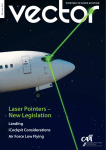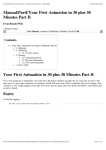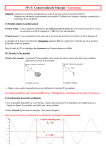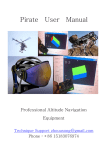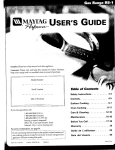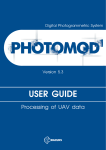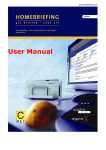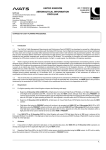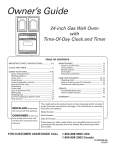Download CAA Instructions/Rules on Model Aircraft operation in NZ
Transcript
Model Aircraft With Christmas fast approaching, sales of model aircraft are likely to increase. Although they are widely available and frequently advertised, you may not be aware of the associated rules that protect people, property, and piloted aircraft. I f your model aircraft weighs between 100 grams and 25 kg, you need to be aware of the following Civil Aviation Rules and Model Flying New Zealand (MFNZ) requirements. Key Civil Aviation Rules Civil Aviation Rules, Part 101, prescribes the operating rules for model aircraft. Part 101 requires you to operate your model aircraft in a safe manner so that it doesn’t create a hazard to aircraft, persons and property (rule 101.13). Always read the user’s manual and follow the manufacturer’s instructions. In addition: »» You can’t drop objects in flight if this creates a hazard (rule 101.15) »» You must maintain line of sight with the model aircraft (rule 101.209) »» All other manned aircraft have the right of way (rule 101.213). To view Part 101, see the CAA web site, www.caa.govt.nz, “Rules”. MFNZ Requirements Model Flying New Zealand is currently the only model aircraft association approved by the Director of Civil Aviation. MFNZ inspects models and issues flight permits to members, allowing them to operate in accordance with their operations manual and procedures. Some MFNZ Requirements: »» Radio controlled models with a gross mass between 15 and 25 kg require a MFNZ permit to fly (It’s illegal to fly without one – reflected by rule 101.205). They must also be constructed under the authority of MFNZ. »» Models weighing less than 15 kg that have internal combustion motors 75 cc input or larger, or electric motors 5,000 watts input or larger also require a permit to fly. 14 vector September/October 2013 Those models weighing over 25 kg require additional CAA authorisation to fly under Civil Aviation Rules, Part 19. Safety Guidelines Reports of airspace incursions involving model aircraft demonstrate the need for owners to understand the following rules. 400 feet above ground level when you are within 4 km of an uncontrolled aerodrome boundary – unless authorisation has been granted by the Director of Civil Aviation. To apply for an authorisation email: [email protected]. Unless stated otherwise, these rules do not apply to control line model aircraft. When operating a model more than 4 km from an aerodrome boundary, you can fly higher than 400 feet only if you remain clear of all controlled airspace and: Aerodromes »» operate in a designated danger area (model aircraft/UAS), or You must not operate a model aircraft on or within 4 km of any aerodrome unless the operator has received a ‘Wings’ badge from MFNZ, or is accompanied by someone else that holds one. You need to get prior authorisation from the aerodrome operator, and at a controlled aerodrome, from the relevant ATC unit. For aerodrome contact details, see the Aeronautical Information Publication (AIP) web site, www.aip.net.nz, “Aerodrome Charts”. Once you have authorisation, you must not operate your model over any active runway strip area, or any area that aircraft use for surface movement (control line model aircraft must also remain clear of these areas). Controlled Airspace By lifting off from your back yard, you could be unintentionally infringing controlled airspace. To operate in controlled airspace, you need to receive prior authorisation from the responsible Air Traffic Services (ATS) unit. To view a list of controlled aerodromes and their contact details, see the AIP web site, www.aip.net.nz, “Gen 3.3 – Air Traffic Services”. Section 6 contains an ATS Unit Address List. Height Restrictions You can’t fly your model any higher than »» an authorised person from MFNZ provides the required information listed in rule 101.207 to the New Zealand NOTAM Office. Special Use Airspace To operate in a mandatory broadcast zone, a model aircraft operator must maintain a listening watch on the appropriate frequency and communicate any intentions to other traffic in the zone. In addition, model aircraft can’t operate in low flying zones. The same goes for restricted areas and military operation areas – unless prior authorisation has been granted by the administering authority. Airspace characteristics and designations can be viewed on the Visual Navigation Charts. To purchase these charts see the Airways web site, www.aipshop.co.nz. Meteorological Conditions To fly your model aircraft, the ground visibility must be 3 km or greater and the model must remain clear of cloud. In addition, you can’t fly your model aircraft if the cloud base will prevent you from maintaining sight of the model at all times. Night Operations Model aircraft can be operated at night only if they are flown indoors, or if the flight is conducted outdoors within 100 m of a structure, and below the top of the structure. ©istockphoto.com / andsem / robertmandel / temizyurek Privacy Many model enthusiasts are now fitting cameras to their models, and new types are frequently sold with cameras fitted. If you are using a camera, you need to check that you are in compliance with privacy laws. See the Privacy Commission web site, www.privacy.org.nz. Join a Club Seventy five model aircraft clubs operate nationwide. Become a member to take advantage of local knowledge, learn about safe operating practices, and get a better understanding of rule requirements. See the MFNZ web site, www.modelflyingnz.org, for club contact details and MFNZ requirements. If you have a query regarding model aircraft, email: [email protected]. Air Swimmers: These are not classed as model aircraft. Please follow the manufacturer’s instructions and keep them indoors. Radio Controlled Aircraft: The majority of models fall into Control Line Aircraft: These motorised aircraft are controlled solely by using one or more inextensible wires or cables directly connected to the model. The wire system can’t be longer than 30 m. the model must be maintained at all times. Small toys of less than 100 grams: These are not classed as model aircraft and Civil Aviation Rules do not apply. Model Gliders: Lift is generated solely by the external this category. These are primarily controlled by radio signals from a remote transmitter, and direct visual line-of-sight with Free-flight Aircraft: A model aircraft which, once launched, can no longer be controlled by the operator. aerodynamic forces acting on the aircraft. Remotely Piloted Aircraft M any remotely piloted aircraft, suitable for aerial photography We’ve covered model aircraft on surveillance, use rules, please contact the CAA sophisticated technology that with details about your planned wasn’t even dreamed of when operation. and our rules were written. Aviation regulators worldwide are grappling with the risks and safety issues associated with The current ICAO name for such is Remotely Piloted Aircraft Systems (RPAS). Over time, many terms and acronyms have been used for these aircraft, such as Unmanned Aerial Vehicles want to fly outside the Part 101 It may be that you need an authorisation under Part 19, issued by the Director. For that to happen, the Director these aircraft. aircraft the previous pages, but if you and Systems (UAV and UAS). The CAA has a responsibility to ensure public safety and this comes to the fore when operators want to fly in urban areas. must be assured the proposed operator has potential examined risks and the made provisions for safe operation of the aircraft. Contact the CAA for guidance, email: [email protected]. In the future, more specific provision will be made for pilotless aircraft activities as we update the relevant rules. Work is already under way on this. Model Aircraft and Privacy M odel aircraft and remotely piloted aircraft have the potential to be intrusive when fitted with cameras. Organisations or individuals using such aircraft would have to have a very good reason for collecting personal information in the form of photographs and video, and we would expect them to take care on how the images were used and who they were disclosed to. We would expect users to think through the privacy implications of what they intend to use them for. In this regard, many of our guidelines for CCTV use would also apply in many situations in which aircraft are used. To see those guidelines, go to www.privacy.org.nz and enter “privacy and cctv” in the search window. - Office of the Privacy Commissioner vector September/October 2013 15



